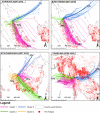Spatial-temporal variability and heath impact of particulate matter during a 2019-2020 biomass burning event in Southeast Asia
- PMID: 35538095
- PMCID: PMC9086666
- DOI: 10.1038/s41598-022-11409-z
Spatial-temporal variability and heath impact of particulate matter during a 2019-2020 biomass burning event in Southeast Asia
Abstract
To understand the characteristics of particulate matter (PM) in the Southeast Asia region, the spatial-temporal concentrations of PM10, PM2.5 and PM1 in Malaysia (Putrajaya, Bukit Fraser and Kota Samarahan) and Thailand (Chiang Mai) were determined using the AS-LUNG V.2 Outdoor sensor. The period of measurement was over a year from 2019 to 2020. The highest concentrations of all sizes of PM in Putrajaya, Bukit Fraser and Kota Samarahan were observed in September 2019 while the highest PM10, PM2.5 and PM1 concentrations in Chiang Mai were observed between March and early April 2020 with 24 h average concentrations during haze days in ranges 83.7-216 µg m-3, 78.3-209 µg m-3 and 57.2-140 µg m-3, respectively. The average PM2.5/PM10 ratio during haze days was 0.93 ± 0.05, which was higher than the average for normal days (0.89 ± 0.13) for all sites, indicating higher PM2.5 concentrations during haze days compared to normal days. An analysis of particle deposition in the human respiratory tract showed a higher total deposition fraction value during haze days than on non-haze days. The result from this study indicated that Malaysia and Thailand are highly affected by biomass burning activity during the dry seasons and the Southwest monsoon.
© 2022. The Author(s).
Conflict of interest statement
The authors declare no competing interests.
Figures




Similar articles
-
Seasonal variation, risk assessment and source estimation of PM 10 and PM10-bound PAHs in the ambient air of Chiang Mai and Lamphun, Thailand.Environ Monit Assess. 2009 Jul;154(1-4):197-218. doi: 10.1007/s10661-008-0389-0. Epub 2008 Aug 8. Environ Monit Assess. 2009. PMID: 18688736
-
Molecular markers for biomass burning associated with the characterization of PM2.5 and component sources during dry season haze episodes in Upper South East Asia.Sci Total Environ. 2019 Mar 25;658:708-722. doi: 10.1016/j.scitotenv.2018.12.201. Epub 2018 Dec 15. Sci Total Environ. 2019. PMID: 30580223
-
Particulates and particulates-bound mercury (Hg(p)) sizes (PM18, PM10, PM2.5, PM1, PM<1) distributions study by using MOUDI sampler at a complex sampling site.Environ Geochem Health. 2020 Feb;42(2):365-375. doi: 10.1007/s10653-019-00360-0. Epub 2019 Jul 8. Environ Geochem Health. 2020. PMID: 31286341
-
Seasonal analysis of indoor and outdoor ratios of PM2.5 and PM10 in Bangkok and Chiang Mai: A comparative study of haze and non-haze episodes.Heliyon. 2025 Jan 24;11(3):e42261. doi: 10.1016/j.heliyon.2025.e42261. eCollection 2025 Feb 15. Heliyon. 2025. PMID: 39916848 Free PMC article.
-
Perspective on Particulate Matter: From Biomass Burning to the Health Crisis in Mainland Southeast Asia.Toxics. 2023 Jun 23;11(7):553. doi: 10.3390/toxics11070553. Toxics. 2023. PMID: 37505519 Free PMC article. Review.
Cited by
-
The effects of ambient particulate matter air pollution on platelets and hemostasis.Front Public Health. 2024 Jul 18;12:1410406. doi: 10.3389/fpubh.2024.1410406. eCollection 2024. Front Public Health. 2024. PMID: 39091522 Free PMC article.
-
A systematic review of spatial and temporal epidemiological approaches, focus on lung cancer risk associated with particulate matter.BMC Public Health. 2024 Oct 24;24(1):2945. doi: 10.1186/s12889-024-20431-x. BMC Public Health. 2024. PMID: 39448953 Free PMC article.
-
Airborne particulate matter from biomass burning in Thailand: Recent issues, challenges, and options.Heliyon. 2023 Mar 5;9(3):e14261. doi: 10.1016/j.heliyon.2023.e14261. eCollection 2023 Mar. Heliyon. 2023. PMID: 36938473 Free PMC article.
-
Associations Between Individual Health Risk Perceptions and Biomarkers of PAH Exposure Before and After PM2.5 Pollution in the Suburbs of Chiang Mai Province.Toxics. 2025 Jun 11;13(6):491. doi: 10.3390/toxics13060491. Toxics. 2025. PMID: 40559964 Free PMC article.
-
Emission Factors of CO2 and Airborne Pollutants and Toxicological Potency of Biofuels for Airplane Transport: A Preliminary Assessment.Toxics. 2022 Oct 18;10(10):617. doi: 10.3390/toxics10100617. Toxics. 2022. PMID: 36287897 Free PMC article.
References
-
- Amnuaylojaroen T, Surapipith V, Macatangay RC. Projection of the near-future PM2.5 in Northern Peninsular Southeast Asia under RCP8.5. Atmosphere. 2022;13:1–19.
-
- Yabueng N, Wiriya W, Chantara S. Influence of zero-burning policy and climate phenomena on ambient PM2.5 patterns and PAHs inhalation cancer risk during episodes of smoke haze in Northern Thailand. Atmos. Environ. 2020;232:117485. doi: 10.1016/j.atmosenv.2020.117485. - DOI
-
- Chantara S, Sillapapiromsuk S, Wiriya W. Atmospheric pollutans in Chiang Mai (Thailand) over a five-year period (2005–2009), their possible sources and relation to air mass movement. Atmos. Environ. 2012;60:88–98. doi: 10.1016/j.atmosenv.2012.06.044. - DOI
-
- Moran J, NaSuwan C, Poocharoen OO. The haze problem in Northern Thailand and policies to combat it: A review. Environ. Sci. Policy. 2019;97:1–15. doi: 10.1016/j.envsci.2019.03.016. - DOI
Publication types
MeSH terms
Substances
LinkOut - more resources
Full Text Sources
Research Materials
Miscellaneous

